|
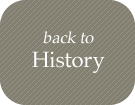 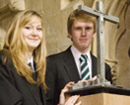 w130.jpg) 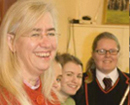 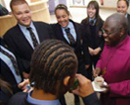 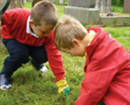 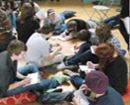 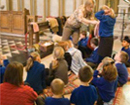 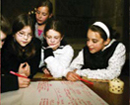 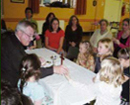
History material
- key stage 3
History - Every Building Tells a Story: Teachers notes
Jump to Programme of Study for Key Stage 3
Additional Activites
Being a history detective
If it is possible to visit a church building students might like to carry out the following tasks:
 Talk to people who have lived in the neighbourhood for some years about their memories of the building.
(The local vicar or church warden should be able to suggest appropriate people.
It might be possible to arrange to meet them at the church and therefore provide an opportunity to take a
look at the building as well). These are questions students might consider asking the interviewee:
How has their relationship with the church building changed over the years? What has brought about those changes?
In what ways is their family connected to the building? (Through weddings, baptisms etc)
What times in the past has the church played a part in their life? Talk to people who have lived in the neighbourhood for some years about their memories of the building.
(The local vicar or church warden should be able to suggest appropriate people.
It might be possible to arrange to meet them at the church and therefore provide an opportunity to take a
look at the building as well). These are questions students might consider asking the interviewee:
How has their relationship with the church building changed over the years? What has brought about those changes?
In what ways is their family connected to the building? (Through weddings, baptisms etc)
What times in the past has the church played a part in their life?
 Using the churchyard...a glimpse into social history of the community.
This task particularly could be used to develop students skills in putting forward a hypothesis and then testing it out with
evidence found in the churchyard. Using the churchyard...a glimpse into social history of the community.
This task particularly could be used to develop students skills in putting forward a hypothesis and then testing it out with
evidence found in the churchyard.
If it is possible to visit a church and look around the churchyard then arrange for that.
It should be possible to go without anyone from the church needing to be there, but it would be best to ask permission from the vicar
or church warden first.
Use the grave markers to explore the following issues of local history:
Look for family burial areas – who? How many? Can students suggest reasons why they were all buried in this place?
How old were people when they died? Can students draw on any wider historical knowledge to make hypotheses about how they
might have died? Why they might have died? E.g. war, in the workhouse etc.
Can any family trees be drawn up from the grave markers?
What about the average age of death? Can students suggest a hypothesis for the causes of death? Why so many deaths at one time etc?
Looking at the surnames on grave markers – A useful source for hypothesising as to the jobs that people might have had,
where might the surnames have come from etc Consider the most popular surnames on the grave markers – what does this tell us
about the community? About the jobs people had? The static or transient nature of the population of that community
Note: If it is not possible to visit the churchyard, the Open Churches website does contain a lot of information
that students might be able to use to carry out this task. However it will not be possible to do it in the detail that a visit
to a church yard would enable.
Another task you could consider students doing is to explore the significance the church has had in the village or town.
This could be linked to the task where students interview someone about the impact the church has had on their life.
It could also include exploring other aspects of the community – does the pub have any connection with the church?
Are there fields or places linked to the church e.g. Glebe meadow, place names linked to church e.g. ‘Kirk’ =
Kirklington, street names linked to church e.g Church Rd...Church Lane. Students could use the website to find historical
plans or maps of the community to see how it has changed or not over time.
 Teachers note: The website material has been produced by local researchers and supervised by history professors at the University of Nottingham. Some of the information is therefore quite academic in parts and may be difficult for some students to access. It is suggested that students work on these activities in mixed ability groupings. In preparation teachers may want to explore the suggested churches on the website first and then select those they feel most appropriate for their students to use. Teachers note: The website material has been produced by local researchers and supervised by history professors at the University of Nottingham. Some of the information is therefore quite academic in parts and may be difficult for some students to access. It is suggested that students work on these activities in mixed ability groupings. In preparation teachers may want to explore the suggested churches on the website first and then select those they feel most appropriate for their students to use.
All the activities on these pages relate to the following areas in the Programme of Study for KS3
Key concept
Cultural, ethnic and religious diversity
- Understanding the diverse experiences and ideas, beliefs and attitudes of men, women and children in past societies
and how these have shaped the world.
Key processes
Historical enquiry
Pupils should be able to:
a identify and investigate, individually and as part of a team, specific historical questions or issues, making and testing hypotheses
b reflect critically on historical questions or issues
Using evidence
Pupils should be able to:
a identify, select and use a range of historical sources, including textual, visual and oral sources, artefacts and the historic environment
b evaluate the sources used in order to reach
The materials also provide for students learning in the following areas:
Range and Content
British History
- The development of political power from the Middle Ages to the twentieth century, including changes in the relationship between
rulers and ruled over time, the changing relationship between the crown and parliament,
and the development of democracy
- The way in which the lives, beliefs, ideas and attitudes of people in Britain have changed over time and the factors –
such as technology, economic development, war, religion and culture – that have driven these changes
European and World history
- The impact of significant political, social, cultural, religious, technological and/or economic developments and events
on past European and world societies
The materials also provide the following opportunities for students:
- To investigate aspects of personal, family or local history and how they relate to a broader historical context
- Appreciate and evaluate, through visits where possible, the role of museums, galleries, archives and historic sites in
preserving, presenting and influencing people’s attitudes towards the past
- Make links between history and other subjects and areas of the curriculum, including citizenship.
Particular thanks to Jane Lewis for creating these resources.
|